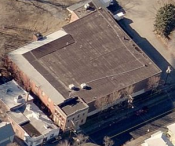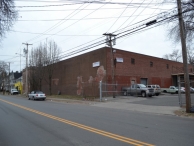Mill Record Bridgeport
RETURN TO ‘FIND MILLS’Disclaimer: Content for these properties was compiled in 2014-2017 from a variety of sources and is subject to change. Updates are occasionally made under Property Information, however the Connecticut Trust for Historic Preservation (dba Preservation Connecticut) makes no representation or warranty that the information is complete or up-to-date.
- Complex Name (Common)
- Bridgeport Coach Lace Co.
- Complex Name (Historic)
-
- Bridgeport Coach Lace Co.
- Address or Location
- 805 Wood Avenue, Bridgeport
- County
- Fairfield
- Historic Designation
- Associated Mill Community
- n/a
- Historic Information
Companies Associated w/Complex
- Bridgeport Coach Lace Co. ca. 1910-1937
- Bridgeport Fabrics Co. 1937-ca. 1960
Use (Historic)
Largest Documented Workforce
300 (1934).
Historic Narrative
The Bridgeport Coach Lace Company was organized in Bridgeport, Connecticut in 1878. The firm was the most recent iteration of an associated line of coach lace manufactures with origins dating back to 1837. The company was initially founded in Bridgeport as a hand weaving coach lace shop by George Carlock, who maintained the business until 1845. It was then reorganized as Leigh and Mills, which operated for just two years before being acquired by Benjamin K. Mills, a native of London, United Kingdom. Benjamin Mills partnered with Thomas Mills, another lace weaver, to form B.K. Mills and Company, and the partners established their first hand weaving coach lace factory on Beaver Street in Bridgeport in 1847. The business was later moved to Cannon Street, where B.K. Mills and Company introduced power looms in an effort to increase efficiency and production during the 1860s. In 1878, B.K. Mills and Company was reorganized and incorporated as the Bridgeport Coach Lace Company. A new mill was established on John Street that same year and the firm continued to occupy this location until 1899 when the business was moved to Wood Avenue. As the business grew, the firm began to manufacture a wide range of carriage trimmings including lace, tassels, and upholstery, however, after carriage-based transportation gave way to the automobile around the turn of the century the Bridgeport Coach Lace Company diversified its catalog to include a variety of automobile trappings. By the 1930s, when automobile accessories comprised all of the company’s production, such products included carpeting, curtain silks, robe rails, curtain cord, and gimp nails. In 1937, the name of the firm was changed in an effort to better reflect the character of the business. At that point the Bridgeport Coach Lace Company became the Bridgeport Fabrics Company. The latter firm employed roughly 300 employees for much of the mid-20th century and remained in business until about 1960. The Wood Avenue plant has since been repurposed for warehouse use, with its present occupant being an HVAC, refrigeration, and plumbing supplier.
- Architectural Information
Number of Existing Buildings
Four (4) adjoining primary blocks.
Dates of Construction
1899, ca. 1910, ca. 1920, ca. 1928, ca. 1960.
Architect
n/a
Builder
n/a
Building Type
Architectural Description
The former Bridgeport Coach Lace Company factory consists of four adjoining primary blocks located on the west side of Wood Avenue, roughly opposite Wood Avenue’s intersection with Staples Street. The most prominent block is a two-story, 35’ x 25’ red brick office building situated at the southeast corner of the plant. The office was erected ca. 1928 and has a concrete foundation, red brick walls, rectangular window openings with concrete sills and spayed concrete lintels, a wide concrete frieze and molded concrete cornice, a stepped red brick parapet with concrete coping, and a flat roof. The building’s façade (east elevation) has been refaced with a hammered concrete tile, this likely during the 1980s. A round concrete plaque that reads ‘A.D./1837’ is centered in the building’s parapet, this referencing the date of the company’s establishment, not the structure’s build date. The primary entrance to the plant is located on the first floor of the block’s façade. This is accessed by four granite stairs and is framed by a cast concrete surround with a wide frieze, molded cornice, and a hipped roof. The word ‘OFFICE’ is embossed in the frieze above the entry. A two-story, 25’ x 88’ red brick block adjoins the west elevation of the office. This was erected to house manufacturing operations ca. 1910. It has segmental-arched window openings with concrete sills on the first floor, rectangular window openings with concrete sills on the second floor, and a front-facing gable roof. A nearly identical two-story, 30’ x 84’ manufacturing block was erected adjoining its north elevation around 1920. This wrapped around the west elevation of a one-story, ca. 1899 block that has since been surrounded and absorbed by later additions and alterations. A similar treatment impacted another one-story, ca. 1899 block located on the north side of the plant around 1960, when the two-story, 115’ x 136’ warehouse comprising the northern three-quarters of the present was constructed. The red brick walls and segmental-arched openings that characterized the ca. 1899 buildings are visible on the east, north, and west sides of the plant, as are the red brick second-story walls with small rectangular window openings that were raised around 1960. The east elevation of the warehouse has been stuccoed and the building has a flat roof.
Exterior Material(s)
Structural System(s)
Roof Form
Roof Material
Power Source
Condition
Fair
Condition Notes
The plant is in fair condition. Much of the historic portion of the factory was heavily altered as part of a warehouse conversion around 1960, however, two early buildings survive largely intact despite some window and façade alterations.
- Property Information
-
Specific Location
One 1.7-acre parcel (805 Wood Avenue) located on the west side of Wood Avenue, roughly opposite Wood Avenue’s intersection with Staples Street.
Adjacent To
n/a
Exterior Visible from Public Road?
Yes
Parcel ID / Assessor Record Link
- 39/1309/1 / Link →
Acreage
1.7
Use (Present)
- Sources
-
Form Completed By
Lucas A. Karmazinas
Date
01/22/2016
Bibliography
- List of Connecticut Manufacturers, 1922, 1924, 1930, 1932.
- Directory of Connecticut State Manufacturers, 1936, 1939.
- Industrial Directory of Connecticut, 1947.
- Register of War Production Facilities in Connecticut, 1951.
- Map of Fairfield County; Baker, William A., 1854.
- Atlas of the City of Bridgeport; J.B. Beers & Co., 1876.
- Atlas of the City and Town of Bridgeport; G.M. Hopkins & Co., 1888, 1917.
- Atlas of Bridgeport; Kershaw, William H., 1910.
- Sanborn Map Company, 1884, 1888, 1898, 1904, 1913, 1939, 1950.
- Aerial Survey of Connecticut, 1934, 1951, 1965, 1970, 1985.
- Bridgeport City Directory, Various editions.
- Hartford Courant, 1934.
- A History of the Old Town of Stratford and the City of Bridgeport; Orcutt, Samuel, 1886.
- History of Bridgeport and Vicinity; S.J. Clarke Publishing, 1917.
- Carriage Museum of America Website.
- Representative View(s)Click on image to view full file






